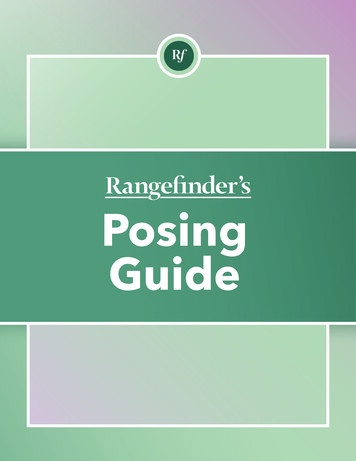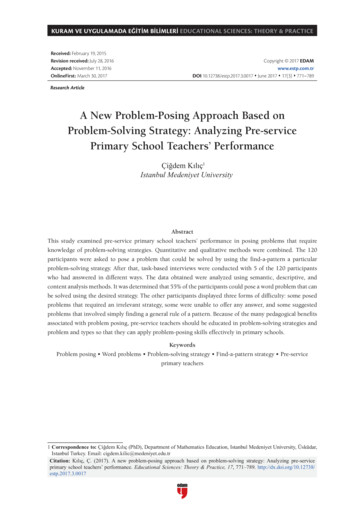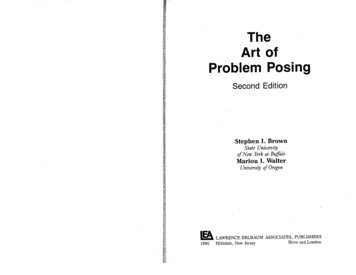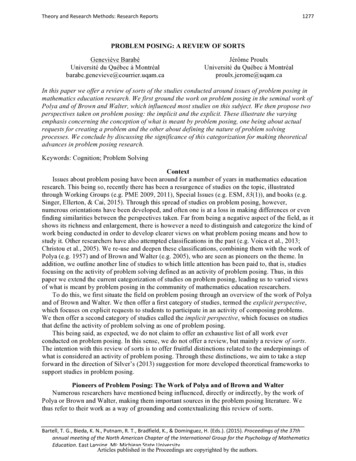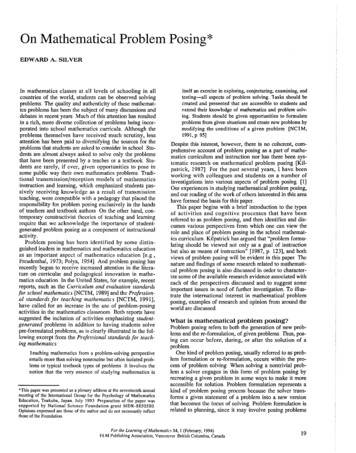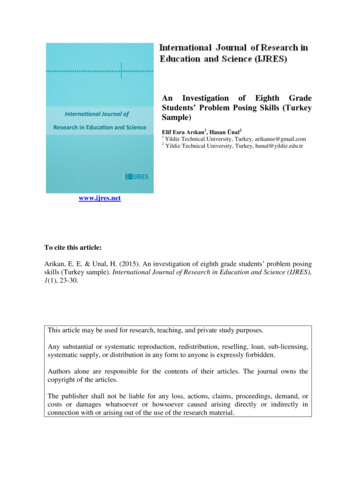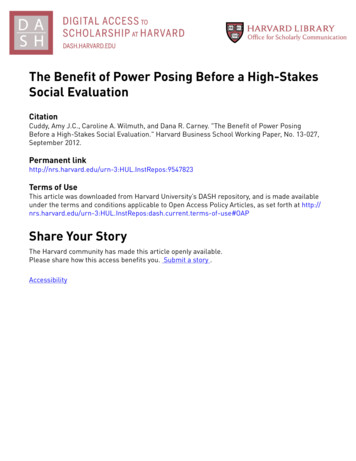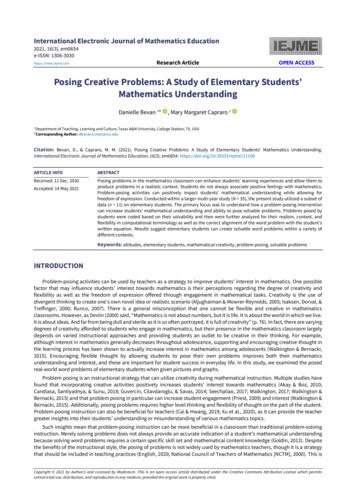
Transcription
International Electronic Journal of Mathematics Education2021, 16(3), em0654e-ISSN: 1306-3030Research Articlehttps://www.iejme.comOPEN ACCESSPosing Creative Problems: A Study of Elementary Students’Mathematics UnderstandingDanielle Bevan 1*, Mary Margaret Capraro 11Department of Teaching, Learning and Culture, Texas A&M University, College Station, TX, USA*Corresponding Author: dbevan114@tamu.eduCitation: Bevan, D., & Capraro, M. M. (2021). Posing Creative Problems: A Study of Elementary Students’ Mathematics Understanding.International Electronic Journal of Mathematics Education, 16(3), em0654. https://doi.org/10.29333/iejme/11109ARTICLE INFOABSTRACTReceived: 11 Dec. 2020Posing problems in the mathematics classroom can enhance students’ learning experiences and allow them toproduce problems in a realistic context. Students do not always associate positive feelings with mathematics.Problem-posing activities can positively impact students’ mathematical understanding while allowing forfreedom of expression. Conducted within a larger multi-year study (N 35), the present study utilized a subset ofdata (n 11) on elementary students. The primary focus was to understand how a problem-posing interventioncan increase students’ mathematical understanding and ability to pose solvable problems. Problems posed bystudents were coded based on their solvability and then were further analyzed for their realism, context, andflexibility in computational terminology as well as the correct alignment of the word problem with the student’swritten equation. Results suggest elementary students can create solvable word problems within a variety ofdifferent contexts.Accepted: 14 May 2021Keywords: attitudes, elementary students, mathematical creativity, problem posing, solvable problemsINTRODUCTIONProblem-posing activities can be used by teachers as a strategy to improve students’ interest in mathematics. One possiblefactor that may influence students’ interest towards mathematics is their perceptions regarding the degree of creativity andflexibility as well as the freedom of expression offered through engagement in mathematical tasks. Creativity is the use ofdivergent thinking to create one’s own novel idea or realistic scenario (Aljughaiman & Mowrer-Reynolds, 2005; Isaksen, Dorval, &Treffinger, 2000; Runco, 2007). There is a general misconception that one cannot be flexible and creative in mathematicsclassrooms. However, as Devlin (2000) said, “Mathematics is not about numbers, but it is life. It is about the world in which we live.It is about ideas. And far from being dull and sterile as it is so often portrayed, it is full of creativity” (p. 76). In fact, there are varyingdegrees of creativity afforded to students who engage in mathematics, but their presence in the mathematics classroom largelydepends on varied instructional approaches and providing students an outlet to be creative in their thinking. For example,although interest in mathematics generally decreases throughout adolescence, supporting and encouraging creative thought inthe learning process has been shown to actually increase interest in mathematics among adolescents (Walkington & Bernacki,2015). Encouraging flexible thought by allowing students to pose their own problems improves both their mathematicsunderstanding and interest, and these are important for student success in everyday life. In this study, we examined the posedreal-world word problems of elementary students when given pictures and graphs.Problem posing is an instructional strategy that can utilize creativity during mathematical instruction. Multiple studies havefound that incorporating creative activities positively increases students’ interest towards mathematics (Akay & Boz, 2010;Candiasa, Santiyadnya, & Sunu, 2018; Guvercin, Cilavdaroglu, & Savas, 2014; Seechaliao, 2017; Walkington, 2017; Walkington &Bernacki, 2015) and that problem posing in particular can increase student engagement (Priest, 2009) and interest (Walkington &Bernacki, 2015). Additionally, posing problems requires higher level thinking and flexibility of thought on the part of the student.Problem-posing instruction can also be beneficial for teachers (Cai & Hwang, 2019; Xu et al., 2020), as it can provide the teachergreater insights into their students’ understanding or misunderstanding of various mathematics topics.Such insights mean that problem-posing instruction can be more beneficial in a classroom than traditional problem-solvinginstruction. Merely solving problems does not always provide an accurate indication of a student’s mathematical understandingbecause solving word problems requires a certain specific skill set and mathematical content knowledge (Goldin, 2013). Despitethe benefits of the instructional style, the posing of problems is not widely used by mathematics teachers, though it is a strategythat should be included in teaching practices (English, 2020; National Council of Teachers of Mathematics [NCTM], 2000). This isCopyright 2021 by Author/s and Licensed by Modestum. This is an open access article distributed under the Creative Commons Attribution License which permitsunrestricted use, distribution, and reproduction in any medium, provided the original work is properly cited.
2 / 10Bevan & Capraro / INT ELECT J MATH ED, 16(3), em0654because few other strategies encourage deeper and richer thinking in mathematics, which can enhance a student’s interesttowards mathematics while improving teacher assessment of student progression in mathematics comprehension.Fostering Problem Posing in Mathematics ClassroomsPosing problems in the mathematics classroom can enhance students’ learning experiences and allow students to producenovel variations in a realistic context. In fact, developing novel methods to solve problems can provide a student greater autonomyin their learning and increase their confidence in mathematics (Lowrie, 2002). Improving students’ mathematical confidence canbe affected by the teacher utilizing three instructional practices: a) providing a variety of opportunities to work with mathematicalconcepts (Calabrese & Capraro, in press), b) sharing and modeling mathematical ideas with other students in a safe environment(English, 2020), and c) challenging activities aligned to the abilities of the students (Fennema et al., 1996; Leikin & Elgrably, 2020).These practices place most of the responsibility of learning on the student rather than the teacher. Providing studentsopportunities to work through posing a problem and feel comfortable enough to make mistakes and ask questions can lead todeveloping more confidence towards mathematics. Furthermore, facilitating discussions in mathematics classrooms allows forstudents to discuss their thoughts in an organized manner. In fact, classroom discussions help students pose problems and allowthem to talk through their unique problem-solving processes (Gavin & Casa, 2012). Discussions during mathematics lessons canunpack mathematical problems and guide students in their learning because guiding questions can be asked by the teacher toencourage students to elaborate on their thought processes (Carpenter et al., 2015). In these ways, teachers can nurture students’learning by providing them ownership of their learning.Groundwork for independent learning can be supplemented by additional strategies for developing mathematical ideas,including using games (Chang et al., 2011) and diagrams (Charalambous, Kyriakides, & Philippou, 2003) to assist in theconstruction of word problems. Thus, incorporating problem-posing activities in mathematics classrooms should be an essentialcomponent of classroom instruction. Problem posing can also be valuable for elementary children because they are perceptiveabout how context is presented to them (Chapman, 2006). Linking mathematics to their real-world experiences (Quintero, 2004)can provide this important context for students. Effective and thoughtful implementation of such strategies makes a teacher’srole vital in problem-posing activities (Silver & Cai, 2005). With supportive learning environments and the ability to engage withchallenging mathematical concepts, students can effectively learn difficult mathematics concepts using problem-posingstrategies. Strategies and implementation may look different from classroom to classroom, but the end goal remains the same:engaging students in the creation of their own mathematical problems.The Benefits of Problem PosingThere are a variety of definitions for what problem posing entails. One definition frames problem posing as the process ofstudents formulating meaningful problems using personal interests (Stoyanova & Ellerton, 1996). Problem posing can be both thecreation of a novel problem and the slight restructuring of given problems (Silver, 1994). There are three classifications of problemsstudents can pose: free, semi-structured, and structured. A problem classified as “free” means a student posed the problemwithout guidelines or information being provided, “semi-structured” is when a student is given a situation and applies priormathematical knowledge when posing a problem, and a posed problem is classified as “structured” when a student is asked tocreate a word problem using a given situation (Stoyanova & Ellerton, 1996).Problem posing requires creative thinking and a more complex understanding of mathematical concepts from students thanstrictly solving word problems. Problem posing also requires students to use previous knowledge and real-world applicationswhen developing problems. The real-world application and creativity used in problem-posing instruction necessitates thatstudents think flexibly and critically. Additionally, increasing opportunities for students to use creativity and real-worldapplications in their learning allows them to become more engaged, leading to increased interest towards mathematics (Cankoy,2014; Chang et al., 2011; Rosli et al., 2014; Sugito et al., 2017; Sung, Hwang, & Chang, 2016; Toluk-Ucar, 2009). This is perhapsbecause when students use their own interests or their classmates’ or their teacher’s names in problems they pose or poseproblems about a particular motivating topic, they realize that mathematics is relevant to their personal interests and lives(Winograd, 1991). Furthermore, problem posing has been shown by previous researchers to increase students’ problem-solvingskills and confidence in mathematics (Cifarelli, 2015; English, 2020; Silver & Cai, 1996). Problem posing can thus provide a powerfullearning experience for students while allowing them to realize that mathematics can be a creative subject, which can potentiallylead to increased interest and confidence in the topic and improved mathematics understanding.Problem posing can also benefit teacher lesson planning and instruction. Because misconceptions are common when learningmathematics concepts, providing opportunities to pose problems allows for teacher insight into their students’ alternateunderstanding or prior mathematics knowledge (Kilic, 2017). Composing a solvable problem can indicate a student’smathematical understanding of various concepts, and a poorly written one can reveal underdeveloped aspects of a student’smathematical understanding (Chang et al., 2011; Toluk-Ucar, 2009). A solvable posed problem includes enough information andcontext to solve the problem. With the information attained from a student’s posed problems, a teacher can introduce specificlessons and strategies into the classroom to better aid that student’s or a group of students’ learning and mathematicalunderstanding.A previous study conducted by Bevan et al. (2019) examined a group of students who displayed positive attitudes towardsmathematics during a problem-posing intervention (N 35). For the purposes of this study, researchers identified students whohad the highest increase in their attitude scores towards mathematics (n 11) and analyzed their posed problems. During thecurrent study, researchers examined the work of these particular students qualitatively to further understand how they posedproblems as well as the relationship between these students and their mathematics understanding. More broadly, the researchers’
Bevan & Capraro / INT ELECT J MATH ED, 16(3), em06543 / 10purpose was to determine the effect of problem-posing intervention activities on elementary students’ mathematicalunderstanding and ability to pose solvable word problems.METHODSThe present study is situated within the larger multi-year study (i.e., Bevan et al., 2019) and utilized a subset of data (n 11) ofelementary students’ responses collected during Spring 2019. The primary focus of the present study was to understand how aproblem-posing intervention can increase students’ mathematical understanding and ability to pose solvable word problems byqualitatively analyzing the responses of the students who had the greatest increase in attitudes towards problem posing asdetermined during the larger study. The classification of problems used for this study were semi-structured. According to VanHarpen and Sriraman (2012), “A problem-posing situation is referred to as semi-structured when students are given an opensituation and are invited to explore the structure of that situation and to complete it by applying knowledge, skills, concepts, andrelationships from their previous mathematical experiences” (p. 205). During our interventions, we asked students to poseproblems using real-world information we provided and to write an equation that matched the posed problem. This providedsome structure in their learning while still allowing students freedom to develop their own problems. For the purposes of ourstudy, we define “equation” as an open standard mathematical statement with a blank or variable written after the equal sign(Powell, 2012). The unique aspect of this study is the application of classification techniques, such as whether a problem wassolvable or realistic and characteristics of the posed problem, to understand similarities among students’ problem-posingresponses.ParticipantsThe targeted second- and fourth-grade (ages 7–9) elementary students (n 11) from the larger study (i.e., Bevan et al., 2019)were the participants for this study. All were enrolled in two Title 1 schools within one district in the southwestern United States.The U.S. Department of Education (n.d.) describes the purpose of Title 1 as “providing funds to provide additional learningsupport, ensuring that all children have a fair, equal, and significant opportunity to obtain a high-quality education and reach, ata minimum proficiency on challenging State academic achievement standards and assessments”. Each school had on average 25students per classroom and two to three classrooms at each grade level. Between the two schools, there were seven second-gradestudents and two fourth-grade students who were the main focus of this study. The demographics for these two schools mirroredthose of the district: 47.5% White, 27.6% Hispanic, 21.2% African American, and 4% others. Parental consent and student assentwere obtained through the university Internal Review BoardInstrumentsResearchers developed six tasks (i.e., four problem-solving and two problem-posing tasks) to be administered before and afterthe intervention. The difficulty of the tasks was adapted to each grade level (second and fourth) and built on the state objectives,which were based on the standards from the National Council of Teachers of Mathematics (2000). Content validity of the problemposing part of the study was verified by two eminent mathematics professors who possess strong research skills and variousproblem-posing publications and who were not part of this research study. Examples of second-grade expectations included usinga pictograph of zoo animals and a farm picture to pose problems using either addition or subtraction, while fourth graders wereasked to pose two-step problems with all four operations when provided with a picture of a cake cut up in fractional parts and ascenario where students start off with 20 and select sandwiches to purchase from a menu. The six tasks were first administeredat the beginning of the semester in early January before the intervention activities began. The exact same six tasks wereadministered four months later at the end of the semester in early May. For the purposes of this study, we only focus on the resultsfrom the problem-posing tasks.The six task responses were evaluated by two researchers whose duties included working together to evaluate the writtenwork of the students’ posed problems. The researchers developed a problem-posing rubric to assess the problems posed onstructure or context (matched the picture, graph, table prompt provided), mathematical equation (the set up matched theproblem posed), and appropriateness (problem was realistic and solvable). The researchers discussed any discrepancies until theyreached 100% agreement. Additionally, researchers analyzed student responses to two problem-posing activities that took placeduring the intervention period.InterventionPreservice teachers (PSTs) who were trained by university faculty met with the second- and fourth-grade students once a weekfor ten weeks. They met with approximately four students in each of their small groups as they rotated through their mathematicslearning centers for 15–20-minute intervals. During the problem-posing groups, elementary students were provided with realworld pictures, objects, or manipulatives to use when they posed problems. During the ten intervention lessons, which werealigned with the state standards on content required to be covered over each school year at different grade levels, the elementarystudents engaged in hands-on activities focused on posing solvable problems. The PSTs encouraged students to evaluate theirnovel problems by determining whether they were solvable, realistic, and formulated appropriately for the specific problemscenario (i.e., picture, graph or equation) they were provided. Activities involved both oral and written tasks.Two activities, those for week five and week eight of the intervention, were chosen for analysis to determine if the elementarystudents used equations to develop word problems throughout the intervention period, which allowed researchers to evaluate ifthey were making connections between the problem posed and the equation provided at specific points in time. For example,
4 / 10Bevan & Capraro / INT ELECT J MATH ED, 16(3), em0654(a)(b)Figure 1. (a) Second- Grade Easter Egg Responses; (b) Fourth-Grade Easter Egg Responsesduring week five, elementary students worked in pairs and were asked to pick an Easter egg that contained a letter correspondingto an equation and then directed to pose their own word problem based on the provided equation. As depicted in Figures 1a and1b, younger students’ content focused on addition and subtraction while upper elementary student content included addition,subtraction, multiplication, and division. The activity for week eight, the popsicle stick activity, required students to choose fiveor seven sticks depending upon grade level—two or three with numbers, one or two with an operation ( , -, x, or ) and one withan sign. Students would then form an equation and pose a problem to match their equation. During other intervention activities,students were provided pictures, menus, grocery advertisements, and toys and asked to pose either a one- or a two-step problemwith one or two operations as a constraint.DATA ANALYSISResearchers qualitatively analyzed responses from the two pre- and post-intervention tasks and the two selected activityintervention tasks. Qualitatively analyzing the students’ responses to the different tasks gave insight into the students’mathematical understanding. Each student’s response was coded first on whether a problem was posed (i.e., did the student aska question or write a statement?). Once this step was determined, each posed problem was classified as solvable or not. Responseswere then analyzed using four criteria to determine if the posed problem had a relationship to the equation provided. Researchersemployed descriptive coding (Saldaña, 2016) and keywords-in-context (Leech & Onwuegbuzie, 2007) to read responses andidentify common themes, words, and methods. This coding was used to find similarities and differences between the students’responses. Data were then coded and categorized then cross compared into themes. Any discrepancies were discussed betweentwo researchers until 100% agreement was reached.RESULTSIn order to delve deeper into the mathematical understanding of the targeted students than initially done in the Bevan et al.(2019) findings, we examined the students’ posed problems through a variety of lenses using the methods described above. First,the researchers examined the posed problems (n 66; six total tasks from each of the 11 students) to determine whether they weresolvable or not. Thirty-six were categorized as solvable and 30 as unsolvable posed problems. An example of an unsolvable posedproblem is the following written by a second-grade student: “Thirets [sic] 2 bears at the zoo, 10 wolfs [sic], 7 tigers, 3 zebras and40 giraffe [sic].” This student did not pose a question stem for the problem thus leaving it unsolvable. An example of a solvableproblem was, “I have 54 eggs. I lost 14 eggs. How many eggs do I have know [sic]?,” as seen in Figure 1a. Within the responses thatwere coded as solvable, the problems posed were further analyzed using descriptive coding (Saldaña, 2016) while looking forkeywords-in-context (Leech & Onwuegbuzie, 2007). The following themes emerged: whether the problem was realistic, variety ofproblem context, flexibility of using various computational terminologies, and correct alignment to the equation. We use thesefour themes to more deeply describe the results.RealisticWriting a word problem may seem somewhat straightforward but making sure the problem is both solvable and realistic takesan extra level of knowledge and computational and contextual understanding. Most of the problems posed were consideredrealistic, but a few could be labeled as unrealistic to an adult audience. For example, a solvable and realistic problem written byone of the second-grade students stated, “There are 10 wolfes [sic] and 7 tigers. How many wolfs [sic] and tigers are theretogether?” This student was using a picture provided to the group and wrote the problem in a format that would allow one of theirclassmates to solve the problem. There was enough information written to set up an addition problem and solve for the total
Bevan & Capraro / INT ELECT J MATH ED, 16(3), em06545 / 10Figure 2. Solvable but Unrealistic Word ProblemFigure 3. Example of Student Work with Different Contextnumber of tigers and wolves using the pictograph. Figure 2 shows an example of a solvable but unrealistic word problem: “Kloehas 46 cats. Heidi gave her 67 more cats. Kloe gave 14 cats to Tayden. How many cats does Kloe have left?” This particular problemwas written by a second-grade student using the equation, 46 67 14 , chosen from an Easter egg during the week fiveintervention activity. This word problem is viewed as unrealistic because there is not much context on why an individual wouldhave so many cats. Furthermore, the names used were those of students in the class and not cat breeders. In other words, Heidi,Kloe, nor Tayden would have owned these large numbers of cats thus making the problem unrealistic.Problem ContextAnother characteristic within the responses is how the students wrote complex problems involving a variety of contexts. Theyused names that were most often the names of their teacher and classmates with whom they were familiar. Students also usedtheir creativity in using different contexts for their problems. During the pre- and post-intervention problem-posing tasks, studentswere given pictures and asked to write a problem. Students tended to use the contents of the pictures (zoo animals or cake) whenposing problems during this activity, but when students were asked to write a problem in the Easter egg and popsicle stickactivities, they would use various contexts that were not eggs or sticks. Students chose to use cars, animals, pencils, food, andbeauty products instead when posing problems during these two activities. For example, one of the students picked the equation(6 12) 3 during the Easter egg activity and was asked to write a problem using the equation. This student decided to useperfume as the context and wrote, “Elle has 6 boxes of 12 perfumes. Her friend, Sara, gave her 3 more separate perfumes. Howmany perfumes does Elle have now?” (see Figure 3). Another example reflected the equation 14 14 14 14 : “My dad mad[sic] 14 pizzas. I order 14 more. Somebody give [sic] us 14. I by [sic] 14 pizzas. How many pizza [sic] do we have at [sic] all?” Amajority of the students used various familiar contexts while posing their problems. In fact, we found that when students areallowed to write problems in a context they are familiar with, they are more likely to formulate a solvable and interesting wordproblem.Flexibility of Operation TerminologyOne characteristic that stood out in student responses was that most students used correct terminology to indicate eithersubtraction, addition, or multiplication. An interesting finding was that the problems posed by the students in the pre-interventionproblem-posing tasks and in the post-intervention problem-posing tasks used correct vocabulary to represent a question byasking “how many” to represent finding the missing result. Most of the students asked their peers to find the total amount ofwhatever objects they used in their posed problem and used the phrases “in all” or “together” frequently when doing so. This wasnot always the case, however. One second-grade student wrote, “I whent [sic] to the zoo and saw 7 tigers and 3 bears how manymore tigers did I see than bears?” (see Figure 4). This student was using a picture provided to the group, but rather than ask for atotal of bears and tigers, this student compared the number of tigers to the number of bears. Solving a comparative problem ischallenging, but creating an original comparison problem requires a high level of mathematical understanding.Another indication of flexibility in operation terminology was when students used the word “more” to represent addition. Onestudent wrote, “Ramsey had 40 pieces of candy she gave 10 to Adrianna then went to buy 15 pieces more how many pieces doesshe have now?” This student’s posed problem indicates the knowledge of “more” representing addition and the phrase “gave 10
6 / 10Bevan & Capraro / INT ELECT J MATH ED, 16(3), em0654Figure 4. Example of Student Work Using Various Operational Terminologyto Adrianna” as subtraction. Indications of flexibility of operation terminology had the potential to involve more abstract thinkingas well.One fourth-grade student selected the following numbers and operators during the popsicle stick activity: , , ,22, 15, 6. Fortheir posed problem, they wrote, “Teagan has 22 lip balms. She bought 15 more over the summer. Elle has 6x as many than Teagan.How many balms does Elle have?” What is interesting about this problem is the student understands the relationship between “ ”and times; in an earlier problem they wrote out “times,” but in this problem they used the “ ” symbol within their word problemto denote “times” or multiplication. By using various terms and methods to represent operations within their problems, thestudents demonstrated not only their awareness and understanding of certain mathematical vocabulary terminology but alsothat they were able to successfully use these terms to align with an equation. Additionally, most proved to be successful in theiruse of the terminology. Table 1 lists out the progression of each student’s ability to pose problems from the two pre-interventiontasks, through the two weekly activities, and finally through the two post-intervention tasks.Correct Alignment to EquationPosing word problems can be an enjoyable activity for students and can enable them to gain interest in learning mathematics;however, one of the most important components of problem posing for students is the ability to align the word problem posed toan equation. Word problems are created within scenarios that hopefully are relatable to students and can enable them tostrengthen their problem-solving skills. Creating a word problem given only an equation without context requires an even higherlevel of mathematical understanding. Out of the posed problems denoted as solvable, 88% of them aligned with a correctequation. Table 2 breaks down only the problems that students correctly aligned to their equations by the following categories:joining, separation, comparison, or multiple operations. Word problems considered as joining included addition in the equationassigned to the student and the problem they posed. Posed problems considered to be separation included subtraction withinthe equation the student chose and the problem they posed. Comparison problems were more complex and used the phrase“more than,” and, lastly, multiple operations were two-step problems that included addition and subtraction or addition andmultiplication.During the popsicle activity, one fourth-grade student the following numbers and operators: 15, 20, , , 14, . The equationthey created was 20 15 14 . Using this equation, the student posed the following problem: “I had 20 pickels [sic]. I went tothe store and bought 15 more then I gave 14 away to my friend how many pickels [sic] did I have left?” We noticed the studentunderstood the relationship between joining items they already possessed and items they bought at the store, and theysuc
Problem posing requires creative thinking and a more complex understanding of mathematical concepts from students than strictly solving word problems. Problem posing also requires students to use previous knowledge and real-world applications when developing problems. The real-world application and creativity used in problem-posing instruction .
